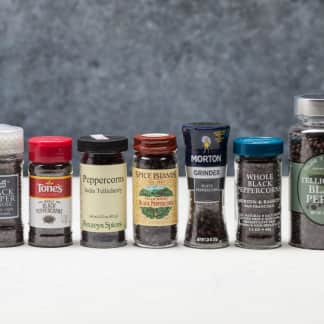A great pepper mill is easy to load with peppercorns and has clearly marked grind settings that are simple to adjust, allowing you to grind pepper in a range of textures from fine to coarse. Our winner, the Cole & Mason Derwent Pepper Mill, has a wide opening at the top of the mill for filling and distinct grind sizes marked on a dial on its base. The OXO Good Grips Mess-Free Pepper Grinder is our Best Buy. Its 2-inch opening made it a breeze to fill and it dispenses pepper from the top, keeping our countertop clear of pepper particles.
A good pepper mill provides us with the freshly ground pepper we use to season food on a daily basis. We typically use pepper mills for only a few seconds at a time, but a poorly designed mill can make a few seconds feel like a lifetime. And if you take on a pepper-heavy recipe such as steak au poivre, which calls for a whole tablespoon of crushed peppercorns, any design flaws become even more apparent.
How does a pepper mill work?
At its simplest, a mill consists of two concentric, grooved burrs that rotate against each other. Cranking the mill forces peppercorns through the space between the burrs, where they’re cracked and crushed into fragments. Because the fragments have to become small enough to pass through that space before they can exit the mill, the fineness of ground pepper can be adjusted by changing the distance between the two burrs. Most mills work pretty much the same way, but their design can vary in how the grind size is adjusted and how they are refilled with peppercorns.
What to Look For
- Wide Opening at Top or Bottom of Mill: All the mills we tested had openings for loading peppercorns, and the sizes and locations of these openings affected how easy it was to fill the mills. The width of the openings ranged from 1 inch to nearly 2 inches, and the bigger the opening, the easier it was to fill the mill. We preferred models that could be loaded from the top or bottom.


- Clearly Marked, Easily Adjustable Grind Settings: The mechanisms used to adjust grind size varied between the models. Most mills had small knobs you twist clockwise (tightening them) for a finer grind and counterclockwise (loosening them) for a coarser grind. It was guesswork to adjust the grind size on models with knobs; there were no clear indicators to let us know where we were between a fine- and a coarse-grind setting. We preferred models that had clearly marked grind settings situated on dials that ringed their bodies. The winning model’s dial had six dots, which represented grind sizes from fine to coarse; it was easy to see exactly which setting we had selected, and we could quickly change to another setting with no guesswork.

We preferred pepper mills that clearly indicated fine and coarse settings (left) to those with no markings at all (right).
- A Range of Accurate and Consistent Grind Sizes: We liked models that gave us consistently fine-, medium-, and coarsely ground pepper. Top-performing mills gave us a full range of accurate grinds that matched whichever grind size they were set to. While most mills produced grinds that matched the setting it was on, one mill’s grind size skewed slightly finer than the grind sizes of the rest of the mills. Another mill’s settings gave us grinds that were slightly more coarse—not a deal breaker but something we’d rather avoid when making dishes where small, subtle particles of pepper are preferred.

- Smooth Grind Mechanism: When it came to grinding, most mills rotated easily, with no major issues. Our favorites rotated in a fluid manner, making them easier and more enjoyable to use.
Nice to Have
- Clear Body: Mills with clear bodies were especially easy to fill, as we could see when we needed to slow our pour to prevent overflows.
What to Avoid
- Narrow Openings: The narrower the opening, the harder the mill was to fill. Models with openings just an inch wide required us to use a funnel to fill them with peppercorns, which was tedious.
- Side-Loading Mills: Side-loading models were frustrating to fill. The cylindrical mills have to be laid on their side and secured in place so that they don’t roll away. While gravity helped guide the peppercorns when filling models with openings on the top or bottom, side-loading models require you to continually adjust the peppercorns to make space for more until the device is full.
- Stiff Grind Mechanism: One mill was noticeably harder to turn than the others, making it feel as if we were grinding pebbles not peppercorns.




















